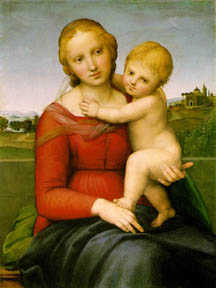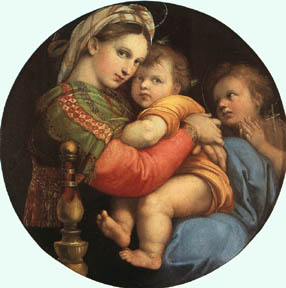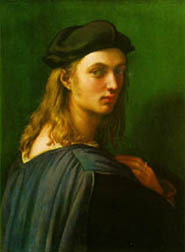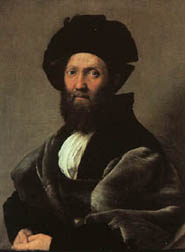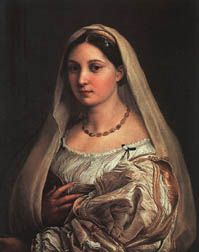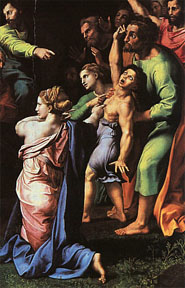https://www.raphaelpaintings.org/
https://www.newworldencyclopedia.org/entry/Raphael
https://www.italian-renaissance-art.com/Raphael.html f.bun
http://www.newadvent.org/cathen/12640c.htm
https://artsandculture.google.com/entity/raphael/m0c43g
Raphael Biography

Raphael was born Raffael Sanzio in the town of Urbino in the year 1483, April 6. No doubt that his interest in painting began quite early; his father was a painter. During the eleven years, which Raphael had with his father, he had the opportunity to learn the basics of painting. His father Giovani Santi worked in the court of Urbino. At the time, it was one of the most renowned courts for the visual arts. With the assistance of his stepmother, the young master had never to struggle in his life. This was in part due to the wealth his father had left behind. In addition, he was friends with the Italian masters of the time. Through these connections, Raphael was able to become quite successful in his career quite early.
His father had apparently managed to secure an apprenticeship for the young master while he was still alive. In the year 1500, Raphael became an apprentice to Petro Perugino, who had been quite successful in the city of Perugia. For four years, Raphael mastered the technique of Perugino. He became so good that it was almost impossible to distinguish between the two. By December of that year, Raphael had earned the title of master' from some quarters. His first known work was the altarpiece for a church that was at the halfway point between his city of birth and Perugia. Evangelista da Pian di Meleto's name features as part of the project from records. The artist had worked on many other projects with Raphael's father. The young master continued to work as an assistant in Perugino's office up until he moved to Florence.
When he eventually left Perugia for Florence, it had become obvious to him that his style need some changes. This is especially considering the recent innovative styles by Leonardo da Vinci and Michelangelo. However, the artist who had the greatest influence on his worker was undoubtedly the former. His influence is visible in the Sistine Madonna by Raphael. However, although he assimilated the styles of different masters of the time, he continued to pursue his own unique style. The work, which had more of Raphael's unique style, was the 'La Belle Jardinere' in the year 1507.
In the year 1508, Raphael moved to work in the Vatican in Rome. He lived out the rest of his life here. His influential family connections also played a huge part in his invitation the Vatican. He managed to be commissioned by Pope Julius II faster than Michelangelo, who had been kept waiting for months after he received official invitation from the pope. His uncle, an architect probably helped put in a good word for him. The first commissioned work by Raphael in Rome was his biggest and best paying ever. He was to do a fresco, in what was to be Pope Julius II private library in the Vatican palace. There was already other works going on at the various rooms. This was mostly to paint over works that had been commissioned by a bitter foe and predecessor of Pope Julius II. The work in the pope's library is known as 'Stanza dellaSegnatura'. The works by Raphael in this room were among the best works by the artist. They include Parnassus, The School of Athens and The Disputation of the Holy Sacrament.
In order to paint his famous works at Stanza dellaSegnatura, he had to paint over some other works. However, Pope Julius II decided these works were less important. After completing the works in the first room, it left Pope Julius II thoroughly impressed. Consequently, he decided to commission the artist for more work in another room. The second room in which Raphael worked is known as the Stanza d'Eliodoro'. In this room, Raphael mostly focuses on the interventions of the divinities on human action. The influence of Michelangelo in these works can be clearly seen. However, like was common throughout his career, the artist manages to use his own unique style, while still absorbing a lot a lot from other masters. At one point, Michelangelo was quite irritated by Raphael's unique skill of absorbing from the masters. He even accused the artist of plagiarism.
During his work on the second stanza, Pope Julius II died. However, this did not have an effect on Raphael's work. Pope Julius' successor, Leo X was impressed by Raphael's work, thus continued to commission him. In addition, a complex web of friends played a significant role in ensuring that he was never in danger of running out of work. He continued to work on projects but played a smaller role. He generally directed the works, leaving his large crew of assistants to handle the actual painting. His large and complex works by him, Leonardo da Vinci, and Michelangelo have come to define the century in which they lived.
At the twilight of his life, Raphael continued to receive commissions from the Vatican. However, he was also received numerous requests for his work. The most notable of his projects outside the Vatican are a series of ten cartons. The works show an evolution in Raphael's style. Essentially, the master's style continued to evolve until his death. In addition, he did a series of portraits. This includes portraits of Pope Julius II and his successor.
His workshop has been described as one of the largest ever owned by a master. No doubt, he drew a lot from the experience of running his father's workshop. Unlike the workshop ran by Michelangelo, Raphael managed to run quite an efficient operation.
The artist even managed to subcontract masters who came with their own assistant, while managing to maintain a good working relationship. His workshop has been credited with producing some of the greatest masters of their time.
When Bramante passed on, Raphael was named as the new architect. However, most of his work was later demolished for being gloomy. However, some of his works still survive in Rome.
Raphael is credited for using drawings extensively. In addition, he was an ardent user of the metal point technique. This involved using a sharp point of silver to make sketches. As seen from his numerous drawings, the artist was quite innovative. Although the artist never made any prints, he entered into a collaboration with another artist. He allowed the artist to use his sketches to come up with engravings.
The artist never got married; this was in spite of his extensive wealth. Although he was at one time engaged, this seems to have been more of a strategic business move than because of love. It is rumored that his numerous romps with his mistresses led to his premature death at thirty-seven years. How this was determined is a matter of great speculation. It is said that he fell ill after a sexual encounter with his mistress Luti. During the next fifteen days, he was well enough to write his will leaving her a huge amount of money. He eventually died and was buried in the Pantheon at his own request.
Without a doubt, Raphael belongs among the top-tier Renaissance artists, and his name has become synonymous with the best of the Renaissance Art. Along with Caravaggio, Donatello, Leonardo da Vinci, Michelangelo, Shakespeare, and a small band of contemporaries, Raphael become the center of a movement of artists that has permanently enriched western and world culture.
His father had apparently managed to secure an apprenticeship for the young master while he was still alive. In the year 1500, Raphael became an apprentice to Petro Perugino, who had been quite successful in the city of Perugia. For four years, Raphael mastered the technique of Perugino. He became so good that it was almost impossible to distinguish between the two. By December of that year, Raphael had earned the title of master' from some quarters. His first known work was the altarpiece for a church that was at the halfway point between his city of birth and Perugia. Evangelista da Pian di Meleto's name features as part of the project from records. The artist had worked on many other projects with Raphael's father. The young master continued to work as an assistant in Perugino's office up until he moved to Florence.
When he eventually left Perugia for Florence, it had become obvious to him that his style need some changes. This is especially considering the recent innovative styles by Leonardo da Vinci and Michelangelo. However, the artist who had the greatest influence on his worker was undoubtedly the former. His influence is visible in the Sistine Madonna by Raphael. However, although he assimilated the styles of different masters of the time, he continued to pursue his own unique style. The work, which had more of Raphael's unique style, was the 'La Belle Jardinere' in the year 1507.
In the year 1508, Raphael moved to work in the Vatican in Rome. He lived out the rest of his life here. His influential family connections also played a huge part in his invitation the Vatican. He managed to be commissioned by Pope Julius II faster than Michelangelo, who had been kept waiting for months after he received official invitation from the pope. His uncle, an architect probably helped put in a good word for him. The first commissioned work by Raphael in Rome was his biggest and best paying ever. He was to do a fresco, in what was to be Pope Julius II private library in the Vatican palace. There was already other works going on at the various rooms. This was mostly to paint over works that had been commissioned by a bitter foe and predecessor of Pope Julius II. The work in the pope's library is known as 'Stanza dellaSegnatura'. The works by Raphael in this room were among the best works by the artist. They include Parnassus, The School of Athens and The Disputation of the Holy Sacrament.
In order to paint his famous works at Stanza dellaSegnatura, he had to paint over some other works. However, Pope Julius II decided these works were less important. After completing the works in the first room, it left Pope Julius II thoroughly impressed. Consequently, he decided to commission the artist for more work in another room. The second room in which Raphael worked is known as the Stanza d'Eliodoro'. In this room, Raphael mostly focuses on the interventions of the divinities on human action. The influence of Michelangelo in these works can be clearly seen. However, like was common throughout his career, the artist manages to use his own unique style, while still absorbing a lot a lot from other masters. At one point, Michelangelo was quite irritated by Raphael's unique skill of absorbing from the masters. He even accused the artist of plagiarism.
During his work on the second stanza, Pope Julius II died. However, this did not have an effect on Raphael's work. Pope Julius' successor, Leo X was impressed by Raphael's work, thus continued to commission him. In addition, a complex web of friends played a significant role in ensuring that he was never in danger of running out of work. He continued to work on projects but played a smaller role. He generally directed the works, leaving his large crew of assistants to handle the actual painting. His large and complex works by him, Leonardo da Vinci, and Michelangelo have come to define the century in which they lived.
At the twilight of his life, Raphael continued to receive commissions from the Vatican. However, he was also received numerous requests for his work. The most notable of his projects outside the Vatican are a series of ten cartons. The works show an evolution in Raphael's style. Essentially, the master's style continued to evolve until his death. In addition, he did a series of portraits. This includes portraits of Pope Julius II and his successor.
His workshop has been described as one of the largest ever owned by a master. No doubt, he drew a lot from the experience of running his father's workshop. Unlike the workshop ran by Michelangelo, Raphael managed to run quite an efficient operation.
The artist even managed to subcontract masters who came with their own assistant, while managing to maintain a good working relationship. His workshop has been credited with producing some of the greatest masters of their time.
When Bramante passed on, Raphael was named as the new architect. However, most of his work was later demolished for being gloomy. However, some of his works still survive in Rome.
Raphael is credited for using drawings extensively. In addition, he was an ardent user of the metal point technique. This involved using a sharp point of silver to make sketches. As seen from his numerous drawings, the artist was quite innovative. Although the artist never made any prints, he entered into a collaboration with another artist. He allowed the artist to use his sketches to come up with engravings.
The artist never got married; this was in spite of his extensive wealth. Although he was at one time engaged, this seems to have been more of a strategic business move than because of love. It is rumored that his numerous romps with his mistresses led to his premature death at thirty-seven years. How this was determined is a matter of great speculation. It is said that he fell ill after a sexual encounter with his mistress Luti. During the next fifteen days, he was well enough to write his will leaving her a huge amount of money. He eventually died and was buried in the Pantheon at his own request.
Without a doubt, Raphael belongs among the top-tier Renaissance artists, and his name has become synonymous with the best of the Renaissance Art. Along with Caravaggio, Donatello, Leonardo da Vinci, Michelangelo, Shakespeare, and a small band of contemporaries, Raphael become the center of a movement of artists that has permanently enriched western and world culture.
Raphael Sanzio
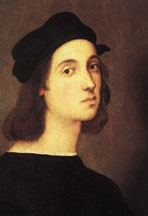 1483-1521 |
Raphael was a painter of the Italian "High Renaissance", considered one of the greatest and most popular artists of all time. Unlike Leonardo and Michelangelo, Raphael was to live a very short life, dying at the youthful age of 38. He was born Raffaello Santi or Raffaello Sanzio in Urbino on April 6, 1483, and received his early training in art from his father, Giovanni Santi. In 1499 he went to Perugia, in Umbria, and became a student and assistant of the painter Perugino. Raphael imitated his master closely, and their painting styles are so similar that art historians have found it difficult to determine which were painted by Raphael, and which were by his master. This was the beginning of his career as an absorber of influences. It is said of Raphael that whatever he saw, he took possession of, always growing by what was taught to him.
 St. George and the Dragon, 1505 | 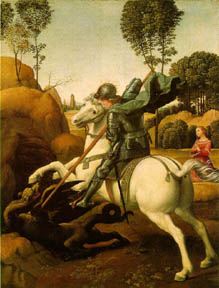 St. George and The Dragon, 1504-6 |
Both of these images of St. George Fighting the Dragon were painted when the artist was in his early twenties. They echo the gentle expression of his teacher, Perugino (especially in the little praying princess). There is, however, a sense of vigor in the knight and his horse and the dragon that was beyond Perugino's skill.
Madonnas
|
Raphael is best known for his many images of Madonnas (some of his most popular ones have been made into postage stamps, above). An interesting irony for these scenes of quiet faith is the notion, recorded by the historian Giorgio Vasari (a contemporary of Raphael's time), that Raphael was an atheist, and that he painted what would be acceptable, not what he felt to be true. He was, however, an appreciator of feminine beauty, and was noted to have been a "ladies man". It is possible that many of the images of Mary were posed by the same woman.
Cowper Madonna, 1504
Madonna of the Chair, 1518It is believed that his Madonnas were particularly influenced by Leonardo, with whom he came under direct influence when Raphael moved to Florence. The small Cowper Madonna, with its softness of contour and perfection of balance, has been noted for its resemblance to some of Leonardo's paintings of the subject. Madonna of the Chair was created more than a decade later, but also reflects the sweetness and harmony that we have come to identify with Raphael. It is considered by many to be the most popular of all Raphael madonnas, and was probably painted for Pope Leo X, or one of the Medici. Of particular interest is the circular design. All of the interlocking arms and legs, and the directional gazes within the picture serve to emphasize the circular composition.
In 1508 Raphael was called to Rome by Pope Julius II and commissioned to execute frescoes in four small rooms of the Vatican Palace. The walls of the first room are decorated with scenes elaborating ideas suggested by personifications of Theology, Philosophy, Poetry, and Justice, which appear on the upper walls. The most famous of these compositions is The School of Athens, which represents the concept of Philosophy. The painting displays the greatest thinkers of the Greek world, most notably Plato and Aristotle, who are at the center of the composition. As with Leonardo's Last Supper, all of the architectural lines lead back to a vanishing point right behind the main center of interest, and the arch doorway serves to emphasize their importance. Though the artist portrays famous thinkers from a thousand years before his time, he uses portraits of his contemporaries to serve the composition. In the place of Plato, for instance, it is likely that the portrait is that of Leonardo. Likewise, Michelangelo is in the foreground (depicted as Heraclitus), leaning against a block. During the time of Leonardo's painting, Michelangelo was also creating the Sistine Chapel frescos (also within the Vatican). A well-known story suggests that Raphael snuck into the Sistine Chapel, while the painting of its ceiling was in progress. Michaelangelo was added after Raphael found himself influenced by the energy and action of Michaelangelo's compositions.Raphael portrays himself in a less significant area of the School of Athens. He peers out at the viewer from the center of a group of scholars that are crowded together at the far right edge of the composition. Probably many of the other persons within the painting are posed by contemporaries. I have noticed the similarity between one figure and a famous portait of a young man named Bindo Altoviti (below).
Portraits
|
For many years, historians believed that youth at left was Raphael himself. He was said to be unusually handsome, pensive, and fair, but it is now agreed that it is Bindo Altoviti at 22 (Raphael was 33, with only five years left to live). I personally find Raphael's portraits to be some of his most compelling works. The portrait of Baldassari Castiglione is a particularly sensitive rendition of a well-known Renaissance humanist writer. La Donna Velata is possibly the same woman who is portrayed in many of his Madonna images, and is believed to have been the painter's mistress. All three portraits are exquisite examples of Renaissance temperance and style.
Last Works(click below images for larger versions)
Raphael's final paintings are some of his most powerful religious works. The Sistine Madonna is his last image of the heavenly mother. It is much more supernatural than his previous works, as Mary treads on pillowy clouds and is surrounded by musing angels. The return of such supernatural images will influence the works of the Mannerist painters, who emulate the dramatic style of Raphael's later works.
The Transfiguration of Christ is the final work of Raphael's life, and is believed to have been unfinished (probably completed by one of his students). Raphael did not paint the standard interpretation of the story, as he combines it with the story of The Healing of the Lunatic Boy. After ascending the "mountain of revelation," Christ was transfigured before the three awestruck apostles. A dramatic white light emanated from behind Christ. Although it is written in the Gospels that the events of The Healing of the Lunatic Boy actually followed The Transfiguration, Raphael joined them at one point in time. In the Gospels the possessed boy was brought to the apostles to be freed of his demonic possession. However the twelve apostles, "small and impotent," were unable to cure the sick child until Christ arrived. The Transfigured Christ, to whom one of the apostles points, is the only help, and the unlifted arms pointing to the vision form the connecting link between the two regions. Their directioning joins the two scenes by announcing that Christ is the savior of man; only he can heal the pains of this life.
(detail of lunatic boy in Transfiguration)Raphael's art has fallen out of favor in contemporary times because it seems almost too perfect and sweet. Many art historians believe that it lacks the dynamic power of Leonardo or Michelangelo's works. However, Raphael was a great artist, who exemplified the tastes of his time. During his lifetime, he was perhaps as famous as the great Michelangelo, and received so many commissions that he had a difficult time keeping up with them. He had a tremendous impact on artists that were to follow him, which is especially significant given his short life. At the age of 38, he contracted a fever, which was probably caused by an insect bite. He would probably have healed, but for the continued practice of medieval medicine, which prompted the doctors to bleed him with leeches, attempting to get the "bad blood" out. One can only wonder what he would have achieved if given the long life spans of Leonardo or Michelangelo. Though much younger than Michelangelo, he died 43 years before him. The death of Michelangelo will mark the end of the High Renaissance. A transitional period, called "Mannerism" will take place for the next 50 years, before the beginning of the Baroque era.





